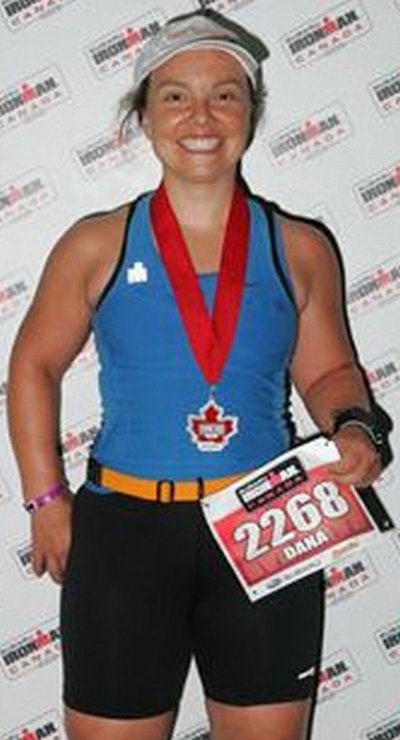October 8, 2009
Dentistry staffer swims, bikes and runs her way through first Ironman event
Dana Robinson Slote is not your average triathlete. At meetings on the UW campus or in the hallways of the Health Sciences building, the outreach and marketing manager is business-proper in her attire, sporting stylish and girly suits from Ann Taylor Loft. She’s not a high heels kind of lady, but upon first glance, a bystander wouldn’t say, “Now, there’s an athlete.”
But all that changed at the end of August. Slote took part in and finished Ironman Canada 2009 in Penticton, British Columbia. An Ironman triathlon is a long-distance race, which means a 2.4-mile open-water swim, 112 miles by bike and a marathon (26.2 miles) to boot. Slote completed the race in 14 hours and 42 minutes.
Finishing a triathlon of any distance is admirable, but an Ironman — with what seems like extreme distances — is another story. What made Slote decide to tackle this feat? “A friend suggested it,” she said, matter-of-factly. “And, as my dad likes to say, with me, there’s no ‘on-deck circle,’ it’s just ‘batters up!'”
Slote had competed in recent years in several short-distance or sprint triathlons, including the popular Danskin race for women. She only began training for the Ironman in April 2009, which made her prep work all the more serious. “I had a pretty good base of fitness to begin with, but it’s been an intense period of time,” she said.
Earlier in the year, Slote was training solo, placing emphasis on running, cycling and building core strength. But once spring hit, she became unsure about the distances she was covering, and if she was doing too much, or too little training. She opted to sign on with a coach, Lesley Mettler, who has competed in several Ironman events and has a background in exercise and sports science. “It was the difference between the first six months and crossing my fingers, and transitioning into being well coached by someone who has a formula that works,” said Slote.
The petite athlete said she thinks anyone can do an Ironman. “You just have to decide that anything is possible, whether it’s an Ironman or some other goal.” As part of her prep, Slote also completed a half-Ironman race, known as ChelanMan, last July.
Athletes who compete at the Ironman level typically have to give up some things in order to dedicate themselves to training. Slote said that certainly happened with her, as she let go of both personal time for things like reading a book, sleep and time spent with her husband, friends and family.
“Those were sacrifices that I was willing to make,” she said. “I gave up sleep because I’d have to wake up at 4:30 a.m. to be at the gym at 5 a.m. I gave up going to more than a few sporting events because I couldn’t stay up late. There’s no point in getting a pedicure when your feet look like they do from training, or why get a haircut when you’re going to wear a ponytail for three months?”
Slote said she’s already seen unexpected benefits from taking part in Ironman. “People I work with who I didn’t know were athletes, or people who’ve tried sprint triathlons are now interested in trying more,” she said. “Even my mom, who had gotten away from exercising, finds herself back on the treadmill after me doing Ironman Canada. That to me means more than any accolades I might receive.”
The dentistry staffer also said she’s been able to apply “lessons learned” from the triathlon training and race to her day job. “I’ve learned that I have the discipline and drive to reach what was seemingly an insurmountable obstacle,” she said. “It became a very obtainable goal, focusing on this moment and what my body needs at this moment.”
Reflecting back, Slote said it took her some time to process what she had really done by taking part in the Ironman.
“Emotions run really high after a race, and it was not until two days after that I really realized what I had accomplished,” she said. “A friend was asking me questions about race day experience, nutrition and fueling, and what was the best part and worst part, and it just hit me. I’m so proud of this new status of “Ironman’ that I’ll have for life.
“It was extraordinary and I didn’t realize how that would impact me on a personal level until long after the fact. I realize that other people will see you differently, and it’s the baseline for everything now. Everything seems very doable in comparison.”
- The Northwest Ironman equivalent: A relative of Dana’s put together an equivalency chart for competing in the Ironman. Here’s what he wrote: What you did is equivalent to: jumping into Lake Washington at the Conibear Shellhouse, swimming to the Evergreen Floating Bridge, swimming parallel along Evergreen Bridge from one shore to the other, climbing up the hill and getting on the bike, riding through Bellevue, to I- 90, riding I- 90 east over Snoqualmie Pass past Cle Elum to the outskirts of Ellensburg, dropping the bike and running to Vantage, up Vantage Hill and onto Moses Lake.
- Are you an Ironman too? Comment on this story below and share your experiences.



